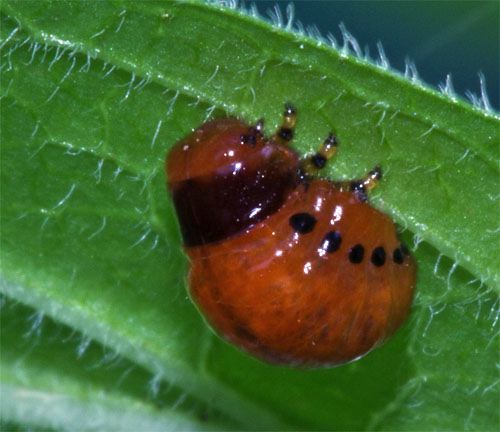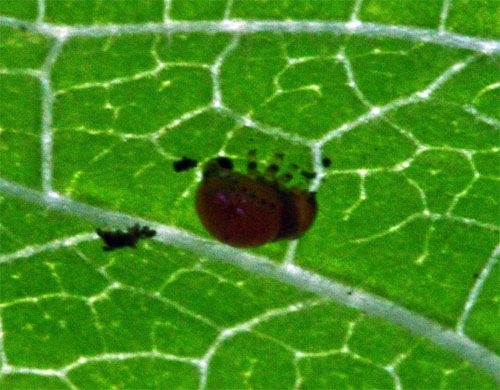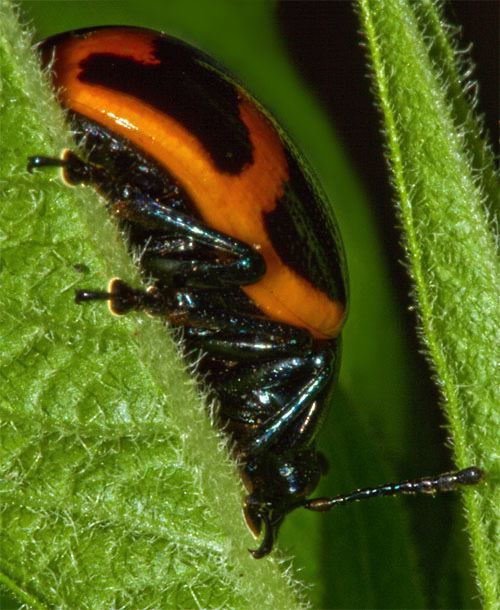|
|
|||
|
(Back to Preceding Week; on to Next Week) |
|
All text & photos © Hilton Pond Center SWAMP MILKWEED LEAF BEETLE Sometime during the mid-1990s a tall purplish-pink wildflower appeared on its own along the banks of Hilton Pond and we were very pleased to see it. The plant was Swamp Milkweed, Asclepias incarnata (above),
All text & photos © Hilton Pond Center This week as we checked our Swamp Milkweed crop for flowers and Monarch larvae we found neither, but atop one stalk perched a nearly half-inch-long beetle in brilliant Halloween colors (above). Considering the plant it was on, we hadn't much doubt about the insect's identity: It was a Swamp Milkweed Leaf Beetle, Labidomera clivicollis, and it appeared to be chewing on unopened flower buds. Insect observers won't be surprised the Swamp Milkweed Leaf Beetle--shall we call it SMLB for short even though it does occur on other milkweed species?--is in the Leaf Beetle Family (Chrysomelidae). As do other beetles, SMLBs undergo complete metamorphosis (egg-larva-pupa-adult), with the larva molting through four "instar" stages--each about twice the size of the one preceding. The last instar drops earthward and burrows into the soil where it pupates. In the Carolinas there apparently are at least two generations, with noticeably smaller individuals being produced during poor environmental conditions such as drought. Some adult SMLBs overwinter hidden in leaf litter or other suitable spots.
All text & photos © Hilton Pond Center The morning after we spotted our adult SMLB on Swamp Milkweed we returned with a 10x hand lens to see if we could locate eggs or immatures. The adult was on an adjoining flower stalk but we couldn't find any eggs, perhaps because around these parts they're usually laid in late May or early June. We did manage to locate baby beetles in a couple of different sizes. The nearly spherical one in the photo above was a little less than a quarter-inch in length and probably a third instar, while the tiny backlit one below likely was a first instar and only about 1/8" long. The black bodies in the image below are even tinier deposits of frass. (NOTE: We worked hard to keep the top photo of the adult beetle and those of the two instars roughly to scale.)
All text & photos © Hilton Pond Center Entomologists have determined Swamp Milkweed Leaf Beetles may utilize several forms of cannibalism, with newly hatched offspring eating their siblings' eggs, older larvae eating eggs of unrelated SMLBs, and adult female SMLBs eating egg clutches from other females. It's curious an insect that's normally phytophagous--plant-eating--engages so readily in cannibalism. However, this behavior not only provides immediate nutrition, it also helps eliminate later competition for food and reduces population densities such that predators on SMLB larvae--mostly spiders or adult and larval flies--have a harder time finding them.
All text & photos © Hilton Pond Center The adult Swamp Milkweed Leaf Beetle stayed within one ten-stalk milkweed colony for at least the last three days of June, wandering from--and dining upon--one flower head after another. We're guessing thanks to the voracious appetites of it and numerous SMLB instars our Swamp Milkweed blossoms will be fewer again this year at Hilton Pond Center. All text & photos © Hilton Pond Center TECH NOTES: Swamp Milkweed Leaf Beetle photos above were made with a Canon 100mm f/2.8 Macro Lens mounted on a Canon 7D with built-in flash and a Canon 12mm Extension Tube II. A Canon 25mm Extension Tube II was used for the 1st instar image (no flash).
|



 a native species that grows in the U.S. and Canada in all states and provinces except on the Pacific Coast. As its common name suggests, Swamp Milkweed does best in moist soil and can even thrive in riparian habitats with roots submerged. Like all milkweeds its ornate flowers are pleasing to the eye, but the real reason we were happy to find it at Hilton Pond Center was because it's a host plant for Monarch butterfly larvae (right)--among the most colorful of all caterpillars. Our Swamp Milkweed colony expanded through the years--flowering profusely each July and propagating itself with winged, windblown seeds--and a few years ago we finally started seeing Monarch caterpillars feeding on milkweed foliage. In 2009, however, our Swamp Milkweeds produced almost no blossoms and hosted no Monarchs and we couldn't figure out why. Now we think we have at least part of the answer.
a native species that grows in the U.S. and Canada in all states and provinces except on the Pacific Coast. As its common name suggests, Swamp Milkweed does best in moist soil and can even thrive in riparian habitats with roots submerged. Like all milkweeds its ornate flowers are pleasing to the eye, but the real reason we were happy to find it at Hilton Pond Center was because it's a host plant for Monarch butterfly larvae (right)--among the most colorful of all caterpillars. Our Swamp Milkweed colony expanded through the years--flowering profusely each July and propagating itself with winged, windblown seeds--and a few years ago we finally started seeing Monarch caterpillars feeding on milkweed foliage. In 2009, however, our Swamp Milkweeds produced almost no blossoms and hosted no Monarchs and we couldn't figure out why. Now we think we have at least part of the answer. 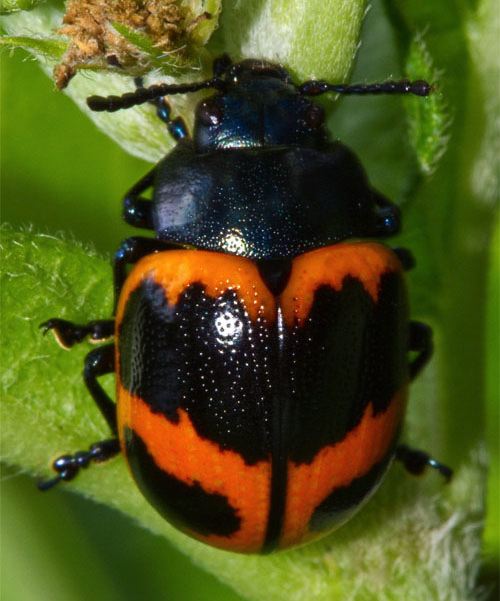
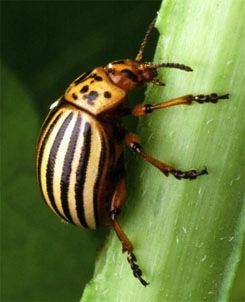 This is a huge coleopteran family with more than 2,500 genera and 35,000 named species worldwide, including such economically important species as Colorado Potato Beetle (right), Cereal Leaf Beetle, and Asparagus Beetle--plus various Flea Beetles that eat both desirable garden plants and unwanted weeds. Some chrysomelid beetles resemble Ladybird Beetles (Coccinelidae), but most--not all--the latter are beneficial predators of other insect larvae and don't dine on flora like SMLBs and their relatives.
This is a huge coleopteran family with more than 2,500 genera and 35,000 named species worldwide, including such economically important species as Colorado Potato Beetle (right), Cereal Leaf Beetle, and Asparagus Beetle--plus various Flea Beetles that eat both desirable garden plants and unwanted weeds. Some chrysomelid beetles resemble Ladybird Beetles (Coccinelidae), but most--not all--the latter are beneficial predators of other insect larvae and don't dine on flora like SMLBs and their relatives.